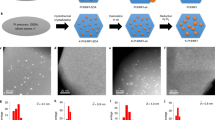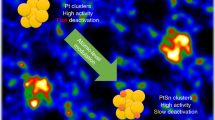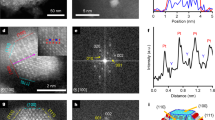Abstract
Single metal atoms and metal clusters have attracted much attention thanks to their advantageous capabilities as heterogeneous catalysts. However, the generation of stable single atoms and clusters on a solid support is still challenging. Herein, we report a new strategy for the generation of single Pt atoms and Pt clusters with exceptionally high thermal stability, formed within purely siliceous MCM-22 during the growth of a two-dimensional zeolite into three dimensions. These subnanometric Pt species are stabilized by MCM-22, even after treatment in air up to 540 °C. Furthermore, these stable Pt species confined within internal framework cavities show size-selective catalysis for the hydrogenation of alkenes. High-temperature oxidation–reduction treatments result in the growth of encapsulated Pt species to small nanoparticles in the approximate size range of 1 to 2 nm. The stability and catalytic activity of encapsulated Pt species is also reflected in the dehydrogenation of propane to propylene.
This is a preview of subscription content, access via your institution
Access options
Subscribe to this journal
Receive 12 print issues and online access
$259.00 per year
only $21.58 per issue
Buy this article
- Purchase on Springer Link
- Instant access to full article PDF
Prices may be subject to local taxes which are calculated during checkout





Similar content being viewed by others
Change history
25 October 2017
In the version of this Article originally published, the four instances of the window type on page 136 should have read '10-MR'. On the same page, in the 'Catalytic activity' section, the accessibility of isobutene was incorrectly described, and the phrase should have read 'isobutene is mainly accessible to Pt species located at the external cups on the surface of MCM-22'. These changes do not affect the results of the Article.
24 March 2017
In the version of this Article originally published, Fig. 5e showed the wrong graph. This has now been corrected in all versions.
25 April 2017
Nature Materials 16, 132–138 (2016); published online 20 December 2016; corrected after print 24 March 2017 In the version of this Article originally published, Fig. 5e showed the wrong graph. This has now been corrected in all versions. The correct figure is shown below.
References
Boronat, M., Leyva-Perez, A. & Corma, A. Theoretical and experimental insights into the origin of the catalytic activity of subnanometric gold clusters: attempts to predict reactivity with clusters and nanoparticles of gold. Acc. Chem. Res. 47, 834–844 (2014).
Flytzani-Stephanopoulos, M. & Gates, B. C. Atomically dispersed supported metal catalysts. Ann. Rev. Chem. Bio. Eng. 3, 545–574 (2012).
Gates, B. C. Supported metal clusters: synthesis, structure, and catalysis. Chem. Rev. 95, 511–522 (1995).
Corma, A. et al. Exceptional oxidation activity with size-controlled supported gold clusters of low atomicity. Nat. Chem. 5, 775–781 (2013).
Yang, M. et al. Catalytically active Au-O(OH)x-species stabilized by alkali ions on zeolites and mesoporous oxides. Science 346, 1498–1501 (2014).
Rivallan, M. et al. Platinum sintering on H-ZSM-5 followed by chemometrics of CO adsorption and 2D pressure-jump IR spectroscopy of adsorbed species. Angew. Chem. Int. Ed. 49, 785–789 (2010).
Zecevic, J., van der Eerden, A. M., Friedrich, H., de Jongh, P. E. & de Jong, K. P. Heterogeneities of the nanostructure of platinum/zeolite Y catalysts revealed by electron tomography. ACS Nano 7, 3698–3705 (2013).
Philippaerts, A. et al. Unprecedented shape selectivity in hydrogenation of triacylglycerol molecules with Pt/ZSM-5 zeolite. Angew. Chem. Int. Ed. 50, 3947–3949 (2011).
Kim, J., Kim, W., Seo, Y., Kim, J.-C. & Ryoo, R. n-Heptane hydroisomerization over Pt/MFI zeolite nanosheets: effects of zeolite crystal thickness and platinum location. J. Catalys. 301, 187–197 (2013).
Goel, S., Wu, Z., Zones, S. I. & Iglesia, E. Synthesis and catalytic properties of metal clusters encapsulated within small-pore (SOD, GIS, ANA) zeolites. J. Am. Chem. Soc. 134, 17688–17695 (2012).
Choi, M., Wu, Z. & Iglesia, E. Mercaptosilane-assisted synthesis of metal clusters within zeolites and catalytic consequences of encapsulation. J. Am. Chem. Soc. 132, 9129–9137 (2010).
Choi, M., Yook, S. & Kim, H. Hydrogen spillover in encapsulated metal catalysts: new opportunities for designing advanced hydroprocessing catalysts. ChemCatChem 7, 1048–1057 (2015).
Kulkarni, A., Lobo-Lapidus, R. J. & Gates, B. C. Metal clusters on supports: synthesis, structure, reactivity, and catalytic properties. Chem. Commun. 46, 5997–6015 (2010).
Guzman, J. & Gates, B. C. Supported molecular catalysts: metal complexes and clusters on oxides and zeolites. Dalton Trans. 1, 3303–3318 (2003).
Leonowicz, M. E., Lawton, J. A., Lawton, S. L. & Rubin, M. K. MCM-22: a molecular sieve with two independent multidimensional channel systems. Science 264, 1910–1913 (1994).
Camblor, M. A. et al. A new microporous polymorph of silica isomorphous to zeolite MCM-22. Chem. Mater. 8, 2415–2417 (1996).
Hyotanishi, M., Isomura, Y., Yamamoto, H., Kawasaki, H. & Obora, Y. Surfactant-free synthesis of palladium nanoclusters for their use in catalytic cross-coupling reactions. Chem. Commun. 47, 5750–5752 (2011).
Duchesne, P. N. & Zhang, P. Local structure of fluorescent platinum nanoclusters. Nanoscale 4, 4199–4205 (2012).
Lu, J., Aydin, C., Browning, N. D. & Gates, B. C. Imaging isolated gold atom catalytic sites in zeolite NaY. Angew. Chem. Int. Ed. 51, 5842–5846 (2012).
Yacamán, M. J., Santiago, U. & Mejía-Rosales, S. in Advanced Transmission Electron Microscopy: Applications to Nanomaterials (eds Francis, L., Mayoral, A. & Arenal, R.) 1–29 (Springer, 2015).
Jena, P., Khanna, S. N. & Rao, B. K. Physics and Chemistry of Finite Systems: From Clusters to Crystals (Springer, 1992).
Yamasaki, J. et al. Ultramicroscopy 151, 224–231 (2015).
Sohlberg, K., Pennycook, T. J., Zhoud, W. & Pennycook, S. J. Insights into the physical chemistry of materials from advances in HAADF-STEM. Phys. Chem. Chem. Phys. 17, 3982–4006 (2015).
Aydin, C., Lu, J., Browning, N. D. & Gates, B. C. A ‘smart’ catalyst: sinter-resistant supported iridium clusters visualized with electron microscopy. Angew. Chem. Int. Ed. 51, 5929–5934 (2012).
Wei, H. et al. FeOx-supported platinum single-atom and pseudo-single-atom catalysts for chemoselective hydrogenation of functionalized nitroarenes. Nat. Commun. 5, 5634 (2014).
Addou, R. et al. Influence of hydroxyls on Pd atom mobility and clustering on rutile TiO2(011)-2 × 1. ACS Nano 8, 6321–6333 (2014).
Jung, U. et al. Comparative in operando studies in heterogeneous catalysis: atomic and electronic structural features in the hydrogenation of ethylene over supported Pd and Pt catalysts. ACS Catal. 5, 1539–1551 (2015).
Agostini, G. et al. Effect of different face centered cubic nanoparticle distributions on particle size and surface area determination: a theoretical study. J. Phys. Chem. C 118, 4085–4094 (2014).
Alexeev, O. & Gates, B. C. EXAFS characterization of supported metal-complex and metal-cluster catalysts made from organometallic precursors. Top. Catal. 10, 273–293 (2000).
Chakraborty, I., Bhuin, R. G., Bhat, S. & Pradeep, T. Blue emitting undecaplatinum clusters. Nanoscale 6, 8561–8564 (2014).
Zheng, J., Nicovich, P. R. & Dickson, R. M. Highly fluorescent noble-metal quantum dots. Ann. Rev. Phys. Chem. 58, 409–431 (2007).
Okrut, A. et al. Selective molecular recognition by nanoscale environments in a supported iridium cluster catalyst. Nat. Nanotech. 9, 459–465 (2014).
Zhou, C. et al. On the sequential hydrogen dissociative chemisorption on small platinum clusters: a density functional theory study. J. Phys. Chem. C 111, 12773–12778 (2007).
De La Cruz, C. & Sheppard, N. An exploration of the surfaces of some Pt/SiO2 catalysts using CO as an infrared spectroscopic probe. Spectrochim. Acta A 50, 271–285 (1994).
Klünker, C., Balden, M., Lehwald, S. & Daum, W. CO stretching vibrations on Pt(111) and Pt(110) studied by sum frequency generation. Surf. Sci. 360, 104–111 (1996).
Stakheev, A. Y., Shpiro, E. S., Jaeger, N. I. & Schulz-Ekloff, G. Electronic state and location of Pt metal clusters in KL zeolite: FTIR study of CO chemisorption. Catal. Lett. 32, 147–158 (1995).
Heiz, U., Sanchez, A., Abbet, S. & Schneider, W. D. Catalytic oxidation of carbon monoxide on monodispersed platinum clusters: each atom counts. J. Am. Chem. Soc. 121, 3214–3217 (1999).
Levitas, V. I. & Samani, K. Size and mechanics effects in surface-induced melting of nanoparticles. Nat. Commun. 2, 284 (2011).
Jiang, H., Moon, K.-s., Dong, H., Hua, F. & Wong, C. P. Size-dependent melting properties of tin nanoparticles. Chem. Phys. Lett. 429, 492–496 (2006).
Nanda, K. K., Kruis, F. E. & Fissan, H. Evaporation of free PbS nanoparticles: evidence of the Kelvin effect. Phys. Rev. Lett. 89, 256103 (2002).
Vajda, S. et al. Subnanometre platinum clusters as highly active and selective catalysts for the oxidative dehydrogenation of propane. Nat. Mater. 8, 213–216 (2009).
Ortalan, V., Uzun, A., Gates, B. C. & Browning, N. D. Direct imaging of single metal atoms and clusters in the pores of dealuminated HY zeolite. Nat. Nanotech. 5, 506–510 (2010).
Koch, C. Determination of Core Structure Periodicity and Point Defect Density along Dislocations PhD thesis, Univ. Arizona (2002).
Mathon, O. et al. The time-resolved and extreme conditions XAS (TEXAS) facility at the European Synchrotron Radiation Facility: the general-purpose EXAFS bending-magnet beamline BM23. J. Synchrotron Radiat. 22, 1548–1554 (2015).
Newville, M. IFEFFIT: interactive XAFS analysis and FEFF fitting. J. Synchrotron Radiat. 8, 322–324 (2001).
Acknowledgements
This work was funded by the Spanish Government (Consolider Ingenio 2010-MULTICAT (CSD2009-00050) and MAT2014-52085-C2-1-P) and by the Generalitat Valenciana (Prometeo). The Severo Ochoa Program (SEV-2012-0267) is gratefully acknowledged. L.L. thanks ITQ for a contract. The authors also thank the Microscopy Service of UPV for the TEM and STEM measurements. The HAADF-HRSTEM works were conducted in the Laboratorio de Microscopias Avanzadas (LMA) at the Instituto de Nanociencia de Aragon (INA)-Universidad de Zaragoza (Spain), a Spanish ICTS National Facility. Some of the research leading to these results has received funding from the European Union Seventh Framework Program under Grant Agreement 312483-ESTEEM2 (Integrated Infrastructure Initiative-I3). R.A. also acknowledges funding from the Spanish Ministerio de Economia y Competitividad (FIS2013-46159-C3-3-P) and the European Union Horizon 2020 research and innovation programme under the Marie Sklodowska-Curie grant agreement No. 642742.
Author information
Authors and Affiliations
Contributions
A.C. conceived the project, directed the study and wrote the manuscript. L.L. carried out the synthesis, characterization and catalytic measurements and collaborated in writing the manuscript. U.D. participated in the synthesis and characterization of the materials. R.A. performed the high-resolution STEM characterization. G.A. performed the XAS measurement and analysed the data. P.C. carried out the H2–D2 exchange and CO-IR adsorption experiments. U.D., R.A., G.A. and P.C. also collaborated in writing the manuscript.
Corresponding author
Ethics declarations
Competing interests
The authors declare no competing financial interests.
Supplementary information
Supplementary Information
Supplementary Information (PDF 6910 kb)
Rights and permissions
About this article
Cite this article
Liu, L., Díaz, U., Arenal, R. et al. Generation of subnanometric platinum with high stability during transformation of a 2D zeolite into 3D. Nature Mater 16, 132–138 (2017). https://doi.org/10.1038/nmat4757
Received:
Accepted:
Published:
Issue Date:
DOI: https://doi.org/10.1038/nmat4757
This article is cited by
-
Co-aromatization of methane and hexane over Pt encapsulated in ZSM-5 zeolite and the electronic effect of K promoters
Science China Chemistry (2024)
-
Synthesis of Novel Catalytic Styrene Aerobic Oxidation Catalysts via Embedding Co and Ce
Catalysis Letters (2024)
-
Boosting propane dehydrogenation of defective S-1 stabilized single-atom Pt and ZnO catalysts via coordination environment regulation
Nano Research (2024)
-
COx hydrogenation to methanol and other hydrocarbons under mild conditions with Mo3S4@ZSM-5
Nature Communications (2023)
-
Germanium-enriched double-four-membered-ring units inducing zeolite-confined subnanometric Pt clusters for efficient propane dehydrogenation
Nature Catalysis (2023)



